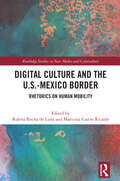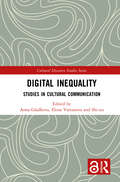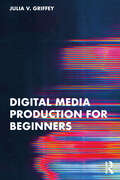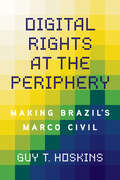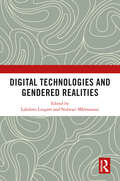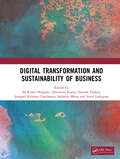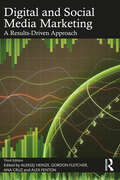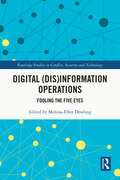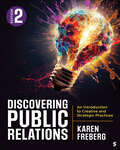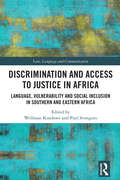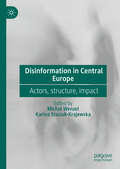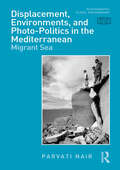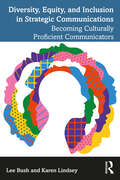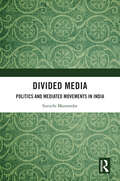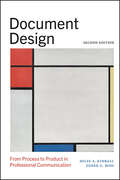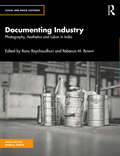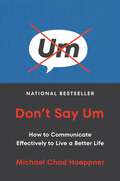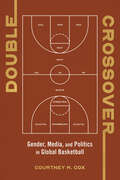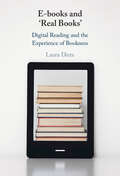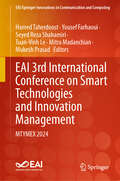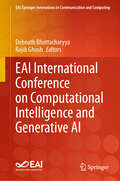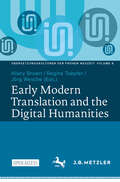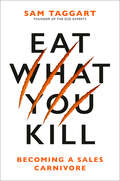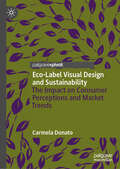- Table View
- List View
Digital Culture and the U.S.-Mexico Border: Rhetorics on Human Mobility (Routledge Studies in New Media and Cyberculture)
by Rubria Rocha de Luna Maricruz Castro RicaldeConceptualizing how digital artifacts can function as a frontier mediated by technology in the geographical, physical, sensory, visual, discursive, and imaginary, this volume offers an interdisciplinary analysis of digital material circulating online in a way that creates a digital dimension of the Mexico-U.S. border.In the context of a world where digital media has helped to shape geopolitical borders and impacted human mobility in positive and negative ways, the book explores new modes of expression in which identification, memory, representation, persuasion, and meaning-making are created, experienced, and/or circulated through digital technologies. An interdisciplinary team of scholars looks at how quick communications bring closer transnational families and how online resources can be helpful for migrants, but also at how digital media can serve to control and reinforce borders via digital technology used to create a system of political control that reinforces stereotypes. The book deconstructs digital artifacts such as the digital press, social media, digital archives, web platforms, technological and artistic creations, visual arts, video games, and artificial intelligence to help us understand the anti-immigrant and dehumanizing discourse of control, as well as the ways migrants create vernacular narratives as digital activism to break the stereotypes that afflict them.This timely and insightful volume will interest scholars and students of digital media, communication studies, journalism, migration, and politics.
Digital Inequality: Studies in Cultural Communication (Cultural Discourse Studies Series)
by Shi-Xu Anna Gladkova Elena VartanovaTracing the development of new technological skills and digital cultures, this book looks at the rise of new digital divides and reveals how these inequalities affect cross-cultural communication from a cultural discourse studies perspective in various ethnic and cultural groups across the world.The authors discuss the development of multicultural societies across the globe under new challenges brought by digitalization, such as digital exclusion, new professional and personal demands in terms of digital engagement. In addition to highlighting digital inequalities in access, use and benefits of using ICTs, case studies from different national contexts demonstrate the ways minority ethnic and cultural groups are adapting to the new digital environment; explore the transformations that multicultural affairs and communication undergo in the new digital setting; and analyse policy measures aimed at fostering digital inclusion of minor groups. The book advances knowledge of the digital divide, showing its development from a technological access- and skill-based problem into a social and culture-oriented one.This resourceful text will be of interest to students and scholars of social inequality, digital media and communication studies and anyone interested in learning how multicultural discourses are developing in varied national contexts today.
Digital Media Production for Beginners
by Julia V. GriffeyWritten for the non-specialist media producer, this book offers a practical and engaging guide to basic digital media production using modern equipment and software.As media production tools and software become more pervasive and traditional media jobs scarcer, today’s media professionals are now expected to be content creators across multiple forms of media, often working with little more equipment than a smartphone. In this accessible manual, Griffey explains how well-crafted media can help sell products, bolster subscriptions, and influence public opinion—and how to go about crafting it in a landscape of high-speed social media consumption. Topics covered include the basics of photography, film, video, and audio production, as well as animation and building websites. Readers will learn not just how to shoot or record content, but also how to edit, compress, and share it, considering the most appropriate file types, equipment, software, and platforms to use for each scenario. After reading this book, students will understand best practices associated with almost every area of media production and possess the essential skills to get the job done.This book is an essential companion for students in communication disciplines, including PR, advertising, journalism, and marketing, looking for a solid grounding in digital media production to prepare them for the competitive job market.
Digital Rights at the Periphery: Making Brazil's Marco Civil (Geopolitics of Information)
by Guy T. HoskinsSigned into law in 2014, the Marco Civil da Internet (Brazilian Civil Rights Framework for the Internet) appeared to offer pioneering legislation for a digital bill of rights that addressed issues like network neutrality and privacy. Guy T. Hoskins chronicles the Marco Civil’s development and its failure to confront the greatest concentration of power in the digital age: informational capitalism. Combining interviews with discourse and political-economic analysis, Hoskins reveals why the legislation fell short while examining the implications of its emergence in Brazil, which remains on the margins of the global system of informational capitalism. Hoskins places collectivist and public service principles at the core of any framework’s effectiveness. He also shows why we must create systems sensitive to the sociocultural and political-economic contexts that will shape digital rights and their usefulness. Compelling and contrarian, Digital Rights at the Periphery looks at communications policy and internet governance in the Global South and the lessons they provide for the rest of the world.
Digital Technologies and Gendered Realities
by Lakshmi Lingam and Nolwazi MkhwanaziThe book explores the varying experiences and engagement of youth with smartphones and digital technologies in India and South Africa. It examines the process of meaning-making (identity construction) garnered through smartphone technology — specifically relating to notions of love, sex, and sexuality.A keen reappraisal of the smartphone revolution, the essays underline the constant negotiations between technology and social institutions such as, family, schools, colleges\universities, religious groups, traditional community leaders, media, police, law, and governments. The volume looks at new forms of digital-based surveillance on girls, women and gender minorities and maps the responses of state, civil society and women’s movements in tackling the divergent narratives of freedom versus control; empowerment versus violence. It specifically looks at how concepts of ‘privacy’, ‘agency’, ‘autonomy’ and ‘consent’ are being framed in the legal arena regarding young women, which may or may not be empowering of their agency and choices.Challenging notions about gender, technology and society, this book will be of great interest to scholars and researchers of sociology and social anthropology, politics, gender studies, and Global South studies.
Digital Transformation and Sustainability of Business
by Dimitrios A Karras Sai Kiran Oruganti Srinesh Singh Thakur Janapati Krishna Chaithanya Sukanya Metta Amit LathigaraIt explores the integration of digital technologies into business models, offering innovative approaches for sustainable growth. This comprehensive guide delves into case studies and strategic frameworks that align digital transformation with environmental and economic sustainability. It presents actionable insights on overcoming challenges, leveraging technology for efficiency, and fostering a competitive edge. Designed for industry leaders, researchers, and policymakers, the book provides evidence-based strategies supported by real-world applications, making it an essential resource for those looking to drive meaningful change in today’s evolving business landscape.
Digital and Social Media Marketing: A Results-Driven Approach
by Ana Cruz Gordon Fletcher Aleksej Heinze Alex FentonNow in its third edition, Digital and Social Media Marketing provides a practice-led approach to digital marketing. This highly regarded textbook combines academic theory with practical examples from a range of different organisations worldwide to highlight techniques for the development and maintenance of a successful digital presence. The book’s customisable models offer organisations a way to decipher their current situation and plan a clear road map for developing a marketing strategy appropriate for the digital era.This rich and accessible textbook has been fully updated to reflect the current global landscape. The content of this third edition has been expanded to: consider the concept of GDPR as a sound framework for responsible marketing offer a greater focus on sustainable marketing throughout, linked to the UN Sustainable Development Goals place emphasis on the importance of crisis and reputation management explore the latest material in big data, data management and data privacy cover the latest in martech trends, particularly related to automation, machine learning and artificial intelligence provide new case studies from China, India, Nigeria and across Asia, alongside student activities and questions designed to improve learning outcomes This textbook provides a hands-on, user-friendly platform to turn skills and knowledge into a strategic advantage. It is ideal for advanced undergraduate, postgraduate and executive students of digital marketing and marketing strategy, as well as for practitioners aiming to be at the cutting edge of digital and social media marketing. Online resources include PowerPoint slides and a test bank.
Digital: Fooling the Five Eyes (Routledge Studies in Conflict, Security and Technology)
by Melissa-Ellen DowlingThis book offers an interdisciplinary insight into the key debates around information warfare in the digital age and argues that transnational cooperation can mitigate the threat.States and societies are increasingly vulnerable to cyber-enabled information operations. From efforts to divide nations, undermine public policy, manipulate elections, and generate social discord, malign actors use the online realm to wreak havoc on our offline lives. The book explores the digital disinformation dilemma that confronts liberal democracies, reflecting on shared socio-political challenges and solutions to contemporary information operations amongst the Five Eyes states and beyond. The work aims to generate a holistic human-centric perspective on the challenges of digital (dis)information operations through interdisciplinary insight into shared challenges and solutions to contemporary information warfare. Together, these perspectives enable us to more effectively identify opportunities to address the challenge and increase the potential to enrich international collaborative efforts to safeguard liberal democracies from threats to their information environments.This book will be of much interest to students of information warfare, intelligence studies, foreign policy and International Relations.
Discovering Public Relations: An Introduction to Creative and Strategic Practices
by Karen FrebergDiscovering Public Relations introduces students to the field of PR in a practical, applied, and hands-on way that prepares them for the modern workplace. Author Karen Freberg highlights modern and contemporary PR practices, emphasizing social media, digital communication, and creative innovation. Understanding that creativity alone can’t create success, Freberg shows students how to choose and implement evidence-based practices to guide their strategic campaigns. The Second Edition transforms students into successful PR professionals by giving them the tools to think creatively, innovate effectively, and deploy research-backed tactics for successful campaigns. This title is accompanied by a complete teaching and learning package. Contact your Sage representative to request a demo. Learning Platform / Courseware Sage Vantage is an intuitive learning platform that integrates quality Sage textbook content with assignable multimedia activities and auto-graded assessments to drive student engagement and ensure accountability. Unparalleled in its ease of use and built for dynamic teaching and learning, Vantage offers customizable LMS integration and best-in-class support. It’s a learning platform you, and your students, will actually love. Learn more. Assignable Video with Assessment Assignable video (available in Sage Vantage) is tied to learning objectives and curated exclusively for this text to bring concepts to life. Watch a sample video now. LMS Cartridge: Import this title’s instructor resources into your school’s learning management system (LMS) and save time. Don’t use an LMS? You can still access all of the same online resources for this title via the password-protected Instructor Resource Site. Learn more.
Discovering Public Relations: An Introduction to Creative and Strategic Practices
by Karen FrebergDiscovering Public Relations introduces students to the field of PR in a practical, applied, and hands-on way that prepares them for the modern workplace. Author Karen Freberg highlights modern and contemporary PR practices, emphasizing social media, digital communication, and creative innovation. Understanding that creativity alone can’t create success, Freberg shows students how to choose and implement evidence-based practices to guide their strategic campaigns. The Second Edition transforms students into successful PR professionals by giving them the tools to think creatively, innovate effectively, and deploy research-backed tactics for successful campaigns. This title is accompanied by a complete teaching and learning package. Contact your Sage representative to request a demo. Learning Platform / Courseware Sage Vantage is an intuitive learning platform that integrates quality Sage textbook content with assignable multimedia activities and auto-graded assessments to drive student engagement and ensure accountability. Unparalleled in its ease of use and built for dynamic teaching and learning, Vantage offers customizable LMS integration and best-in-class support. It’s a learning platform you, and your students, will actually love. Learn more. Assignable Video with Assessment Assignable video (available in Sage Vantage) is tied to learning objectives and curated exclusively for this text to bring concepts to life. Watch a sample video now. LMS Cartridge: Import this title’s instructor resources into your school’s learning management system (LMS) and save time. Don’t use an LMS? You can still access all of the same online resources for this title via the password-protected Instructor Resource Site. Learn more.
Discrimination and Access to Justice in Africa: Language, Vulnerability and Social Inclusion in Southern and Eastern Africa (Law, Language and Communication)
by Wellman Kondowe Paul SvongoroThere are different forms of discrimination. Among others, people can be discriminated against on the basis of their ethnic grouping, political affiliation, race, gender, age, and language. This book focuses on linguistic discrimination in Africa, acknowledging that language plays a key role in the delivery of justice and much of what transpires in justice systems deals with language use. It argues that to achieve fairness, the state has a responsibility to put in place accommodations aimed at reducing linguistic vulnerability. The collection interrogates some of the issues that are common in Africa, which is arguably one of the most linguistically diverse continents in the world, bringing together a collection of case studies from Malawi, South Africa, Zimbabwe, Tanzania, Kenya, and Zambia. It presents practical insights from academics, legal professionals, and social scientists. Divided into five thematic parts, the first addresses communication and linguistic challenges faced by children in the legal system. Theme 2 examines the position of witnesses with physical challenges. The third theme focuses on language as a barrier in access to justice. Theme 4 looks at the language of the court as a major barrier to the poor and the illiterate. The fifth and final theme examines the position of women in sexual assault cases. The collection will be of interest to academics, researchers, and policymakers working in the areas of law and language, human rights law, criminology, linguistics, and African Studies.
Disinformation in Central Europe: Actors, structure, impact
by Michał Wenzel Karina Stasiuk-KrajewskaThis book presents different approaches to disinformation based on original data from quantitative and qualitative studies conducted within CEDMO (Central European Digital Media Observatory). The linguistic and visual features of this type of communication are analyzed in the context of the discursive and genre framing of fake news. The authors discuss the psychological mechanisms of the reception of manipulated content, as well as the legal and political contexts of disinformation in Central Europe (Poland, the Czech Republic, Slovakia). The book presents the results of comparative research on attitudes to Covid-19 and the war in Ukraine, linking the two. The volume contains not only empirical studies, but also an elaborate proposal for a theoretical approach to manipulated content and a coherent methodological model that can be used to deepen scientific knowledge of this complex area of study.
Displacement, Environments, and Photo-Politics in the Mediterranean: Migrant Sea (Photography, Place, Environment)
by Parvati NairFocusing on the Mediterranean region from 2015 onwards, this volume explores photography’s engagement with displacement, a process that denotes the environmental and social breakdown of places and the forced mobility of people.The ongoing proliferation of photography of the displaced plays a crucial role in shaping opinions, by sensitising the public to the despair of displacement and hardening them to the trope through repeated exposure. Through a range of images by both established and amateur photographers, as well as ethnographic notes that draw from interviews with actors who are either displaced or working with the displaced, Parvati Nair questions the extent to which photography opens a space of possibility for the displaced in the face of globally dominant ideological drives that lead to the Anthropocene. Chapters focus on key aspects of this mass phenomenon, such as the question of crises no longer as exception but as historical process, the lived experiences of protracted relegation to borders and exposure to possible death, the prevalence of domicide and the spread of encampments, and the question of hope for the future.The book will be of interest to scholars in photography theory, migration and refugee studies, art history, Mediterranean studies, and political science.
Diversity, Equity, and Inclusion in Strategic Communications: Becoming Culturally Proficient Communicators
by Karen Lindsey Lee BushTaking a DEI-first approach, this book teaches students to become culturally proficient communicators by approaching diversity, equity, and inclusion (DEI) with intentionality in every aspect of strategic communications. Those who work in strategic communications play a powerful role in shaping public perceptions and thus have a crucial responsibility to understand and practice the principles of diversity, equity, and inclusion in their work. This book introduces students to DEI theories and concepts and guides them through applying these concepts to communications research, planning, and execution. Chapters in the book align with the courses and competencies most often taught in advertising and public relations programs. It also includes chapters on “Inclusive Leadership” and “Working on Diverse Teams,” as students will need these competencies when working on group class projects and in preparing for internships. The concluding chapter on “Communicating for Social Change” allows students to look beyond advertising and PR as corporate-centered disciplines and expand their understanding of the power of communications to advocate for social justice and change. Ideal for students at the undergraduate level with relevance to graduate students as well, the book can be used as a stand-alone text in DEI communications courses, as a supplement to core advertising or public relations texts, or in modules in advanced communications courses. Online materials for instructors include teaching tips, suggested discussions and activities, student assignments, sample quizzes, and video links. They are available at www.routledge.com/9781032533865.
Divided Media: Politics and Mediated Movements in India
by Suruchi MazumdarThis book addresses the complex relationship between India’s evolving, emerging media landscape, the political and economic interests of diverse media actors, and movements opposing contentious issues such as market-based economic reforms and religious nationalism.Through the complexities of mainstream news media and emerging digital culture in the eastern city of Kolkata, this book foregrounds regional and linguistic variations in the studies of media, movements, and politics in India. By focusing on popular movements against agricultural land acquisition in the state of West Bengal, in 2006 and 2007, and contemporary citizen-led activisms, this book captures the tension between mainstream media’s political and commercial logic, movements and digital activisms questioning dominant development and religious nationalist agenda, and the possibilities of political diversity and democratic participation. Situating the study in a multi-hybrid digital space that intimately integrates the old and new media, this book draws on critical, thematic analysis of newspaper coverage, digital qualitative studies of techno-commercial features such as hashtags and viral videos, and extensive interviews. This book proposes the theoretical concept of a hybrid partisan system, and argues that heterogeneity –– the complex, dynamic interaction of commercially-run media’s political alliances, the commercial logic, and hybrid professional norms –– remains consequential for movement visibilities, but contributes to deep ambiguities and commonalities in core issues such as industrialization in a developing economy.This book would be relevant to scholars of journalism, political communication, media systems, and mediated activisms in communication studies, sociology, political science, and South Asian studies.
Document Design: From Process to Product in Professional Communication (SUNY series, Studies in Technical Communication)
by Miles A. Kimball Derek G. RossIntroduces students to the basic principles and theories of design, combining practical advice about the design process with a foundation in visual rhetoric and usability.Document Design introduces students to the basic principles and theories of design, combining practical advice about the design process with a foundation in visual rhetoric and usability. Most books on document design lean toward either theory or practice. This book offers a balanced approach-theoretically informed practice-that introduces a working vocabulary to help students become reflective practitioners, able not only to create effective designs but also to explain why and how they made their design choices. Derek G. Ross and Miles A. Kimball hope to give students the foundation they need to make design decisions in any rhetorical situation. Students will learn to negotiate between the needs of both users and clients to consider the nuances of audience, purpose, and context.
Documenting Industry: Photography, Aesthetics and Labor in India (Visual and Media Histories)
by Rebecca M. Brown Ranu RoychoudhuriWhether a smoky portrait of a coal mine or a sweeping shot of workers building an immense dam, photographs of established and emerging industries fundamentally shaped the visual culture and politics of South Asia in the decades after independence. This volume engages with the image of the laboring body against monumental machines, dams, and infrastructure and the ways in which photography engages with strands of modernist aesthetics to support new modes of seeing the changing industrial landscape and the human body.The multidisciplinary essays in the book embrace the porosity of “documentary” and “journalistic” photography and draw out questions of aesthetics in relation to both modernizing calls to industry and modernist framings of the visual in India. The book looks back at photographs from the twentieth and twenty-first centuries and critically considers post-World War II industry—with its imagery of factories belching pollutants into the air and the reality of massive displacements of workers due to epidemics, floods, and drought. It analyzes these images in relation to contemporaneous understandings of aesthetics and in dialogue with recent understandings of the global climate crisis. The volume probes the co-constitution of industry and photography in postcolonial India by looking at selected sites of industrial and artistic practices and their interwoven histories.Part of the Visual Media and Histories Series, this book will be of interest to students and researchers of the history of photography, visual media studies, Indian history, art history, cultural studies, and South Asian studies.
Don't Say Um: How to Communicate Effectively to Live a Better Life
by Michael Chad HoeppnerCommunicate with confidence and improve your presentation skills with this essential guide–because delivery matters. Michael Chad Hoeppner has coached presidential candidates, prominent CEOs, and Ivy League deans on their communication skills. Now, he shares his wide‑ranging knowledge in Don't Say Um. Hoeppner has created an entirely new approach to communication training, providing physical exercises to quickly improve speaking. With simple-to-master exercises, Don&’t Say Um is an essential tool for improving your speech. Don't Say Um challenges our preconceived notions of good speaking techniques and offers powerful tools to become master communicators.
Double Crossover: Gender, Media, and Politics in Global Basketball (Studies in Sports Media)
by Courtney M. CoxAs they compete in leagues around the world, elite women’s basketball players continually adjust to new cultures, rules, and contracts. Courtney M. Cox follows athletes, coaches, journalists, and advocates of women’s basketball as they pursue careers within the sport. Despite all attempts to contain them or prevent forward momentum, they circumvent expectations and open new possibilities within and outside of the game. Throughout the book, Cox explores the intersection of race and gender against the backdrop of the WNBA, NCAA, and other leagues within the United States and around the world. Blending interviews and participant observation with content analysis, she charts how athletes and advocates of women’s hoops illuminate new forms of navigating the global sports-media complex. Timely and original, Double Crossover takes readers into the lived world of women’s basketball to shed light on the struggles, triumphs, and contributions of today’s players and those around them.
E-books and ‘Real Books’: Digital Reading and the Experience of Bookness
by Laura DietzOn any given day, millions of people will read e-books. Yet many of us will do so while holding them apart from 'real books'. The fact that a book can be worthy – of our time, money, respect, even love – without being 'real' is a fascinating paradox of twenty-first century reading. Drawing on original data from a longitudinal study, Laura Dietz investigates how movement between conceptions of e-books as ersatz, digital proxy, and incomplete books serves readers in unexpected ways. The cultural value of e-books remains an area of intense debate in publishing studies. Exploring the legitimacy of e-books in terms of their 'realness' and 'bookness', Dietz enriches our understanding of what e-books are, while also opening up new ways of thinking about how we imagine, how we use, and what we want from books of every kind. This title is also available as Open Access on Cambridge Core.
EAI 3rd International Conference on Smart Technologies and Innovation Management: MTYMEX 2024 (EAI/Springer Innovations in Communication and Computing)
by Yousef Farhaoui Mukesh Prasad Hamed Taherdoost Mitra Madanchian Seyed Reza Shahamiri Tuan-Vinh LeThis book presents the proceedings of 4th EAI International Conference on Smart Technology (MTYMEX), which took place March 28-29, 2024, Vancouver, B.C., Canada. MTYMEX is an international conference aimed at demonstrating the potential of new applications for the Internet in the future. The authors offer perspectives on research on smart technologies in society, including the results of research projects on virtual reality, block chain, artificial intelligence, and smart cities. The book offers examples of applications with smart technologies in different knowledge areas. The conference brings together the academic, research and private sectors working on applications and smart devices for e-health and smart cities.
EAI International Conference on Computational Intelligence and Generative AI (EAI/Springer Innovations in Communication and Computing)
by Debnath Bhattacharyya Rajib GhoshThe book presents the proceedings of the EAI International Conference on Computational Intelligence and Generative AI (ICCIGAI 2024), which took place March 8-9, 2024, in Guntur, India. The book explores the exciting and rapidly evolving field of artificial intelligence, with a specific focus on computational intelligence and generative models. The conference introduces cutting-edge techniques and methodologies that enable machines to simulate human-like intelligence and creativity. Readers can find a comprehensive overview of state-of-the-art AI methods, including neural networks, evolutionary algorithms, deep learning, and generative adversarial networks (GANs). The conference explores real-world applications in a range of areas, including computer vision, natural language processing, and the creation of original content.
Early Modern Translation and the Digital Humanities (Übersetzungskulturen der Frühen Neuzeit #8)
by Hilary Brown Regina Toepfer Jörg WescheThis open-access volume explores how digital resources and methods can be usefully employed for research on early modern translation. The volume focuses mainly on digital resources, and features a number of chapters on translation-specific resources written by members of the teams leading the projects. The resources presented here encompass translations into and/or out of Greek, Latin, the European vernaculars, and Jewish languages (Hebrew, Yiddish, Ladino and Judeo-Italian) and different corpora including plays, encyclopedias, and ‘radical’ texts. While the use of digital methods to analyse early modern translations is still in its early stages, the volume also considers how methods such as data visualisation could shed new light on translation phenomena.
Eat What You Kill: Becoming a Sales Carnivore
by Sam TaggartFrom the founder and CEO of multimillion dollar sales empire D2D Experts, a battle guide to closing more deals than you ever thought possible.Just ten years ago, Sam Taggart was beating the streets as a door-to-door salesman selling solar and alarm systems, getting thousands of doors slammed in his face – and worse – every day. Now, Sam is the founder and CEO of D2D Experts, a seven-figure sales empire that offers training to an active userbase of 30,000 members. Eat What You Kill is the key to mastering the art of sales - and it all starts with a simple mindset shift.In this practical guide, Sam Taggart teaches readers to be sales carnivores – conquerors with limitless potential – instead of herbivores – victims who make excuses for their failures. No matter what you're selling or how you do it, this book is chock full of winning advice for closing every deal, such as: how to build your own pipeline instead of relying on opportunities from higher-upshow to build a healthy 'sales routine' to maximize earnings and minimize burnouthow to build bullet-proof pitches tailored to the four types of prospecthow to properly frame rejection so you don't lose steamFrom improvisational tips to take your pitches to the next level, to activating your &“prey drive&” to supercharge prospecting, Eat What You Kill is the synthesis of everything Sam Taggart has learned on his way to becoming the world&’s best salesman.
Eco-Label Visual Design and Sustainability: The Impact on Consumer Perceptions and Market Trends
by Carmela DonatoThis book delves into the critical role of eco-labels as signals in a marketplace increasingly driven by consumer demand for sustainable products. It begins with an exploration of how eco-labels function within a tripartite system involving consumers, producers, and third-party certifiers, highlighting the challenges and opportunities in their creation, promotion, and validation. Building on this foundation, the book examines the influence of visual aesthetics on consumer perceptions, drawing from aesthetic psychology and marketing literature to explore how design elements—such as visual and conceptual complexity, color, and text—affect consumer attitudes and trust. The empirical core of the book evaluates real-world eco-labels, analyzing how their visual design impacts sustainability perceptions and label adoption. By synthesizing theoretical insights and empirical findings, the book offers practical recommendations for marketers, designers, and policymakers, aiming to improve eco-label effectiveness in fostering sustainable consumer behavior.
